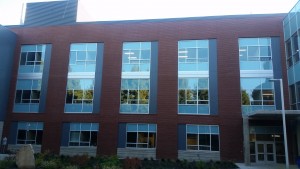The construction of building Science 2 at Central Washington University completed September 2016. As I walked past the building the other day, I thought, how much did it cost in materials for this side of the building? There are many factors to consider when attempting to solve that problem by looking at this picture but for materials there are: brick and mortar, windows, doors and concrete. A possible task of this picture could be for students to determine the cost of the materials in the picture by HSN.Q.A.1 – Reason quantitatively and use units to solve problems. Given how much money per brick, how much money was spent on just bricks? Or it can be solved the other way by giving students the total cost of bricks then find the price per brick. In order to solve those problems, students will have to either count the bricks or do sections of areas. Even cost of labor could be incorporated into the equation for cost of the buildings side.
A teacher can take a picture of just about any construction of say a landscape or a parking lot and relate the problem of cost to unit conversions.

Hi! I really like this activity, there are a lot of components that come into play that could make the activity easier or more difficult which makes it easy to differentiate for your students! Another activity that could be done with this picture is to do an activity about surface area. The students could calculate how much surface area of the building that the windows make up! They could even go collect their own measurements by measuring one of the windows so they had more accurate data when solving for the surface area.
I like the concept of this activity, but I think it needs just a little bit more specificity. If students are asked to figure out how much a big project would cost, it could seem very overwhelming to them. I think it could be better if they were given the cost of a brick, how many total bricks were used, the wages for the workers, amount of total time worked, etc. Or even use a smaller project. On the other hand, this would be a good large scale problem that would require the students to do some research and make decisions about certain things (like total time spent on the project and number of bricks) for themselves.